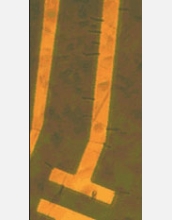News Release 05-044
Building a Better Nanoworld with Microbes

Live bacteria are directed down a channel and trapped by mild electric currents.
March 17, 2005
This material is available primarily for archival purposes. Telephone numbers or other contact information may be out of date; please see current contact information at media contacts.
In a new approach to assembling nanotechnology's atomic-scale machines, a team of scientists at the University of Wisconsin, Madison, has successfully crafted tiny bio-electronic circuits out of live bacteria. Among the potential applications is a new class of sensors that could rapidly detect dangerous biological agents such as anthrax.
Carried out in the laboratories of UW chemist Robert Hamers, with funding from the National Science Foundation, the work was reported today at a meeting of the American Chemical Society in San Diego. The group's formal paper was also posted today in the online edition of the journal Nano Letters; a printed version is scheduled to appear in the journal's April issue.
For more information, see the UW-Madison news release.
-NSF-
Media Contacts
Terry Devitt, UW-Madison, (608) 262-8282, email: trdevitt@wisc.edu
M. Mitchell Waldrop, NSF, (703) 292-7752, email: mwaldrop@nsf.gov
Principal Investigators
Robert J. Hamers, UW-Madison, (608) 262-6371, email: hamers@chem.wisc.edu
Co-Investigators
Joseph D. Beck, UW-Madison, (608) 262-9081, email: jdbeck@wisc.edu
Related Websites
Hamers Research Group: http://hamers.chem.wisc.edu/
Movies of bacteria being directed down a channel: http://www.news.wisc.edu/newsphotos/hamers.html
The U.S. National Science Foundation propels the nation forward by advancing fundamental research in all fields of science and engineering. NSF supports research and people by providing facilities, instruments and funding to support their ingenuity and sustain the U.S. as a global leader in research and innovation. With a fiscal year 2023 budget of $9.5 billion, NSF funds reach all 50 states through grants to nearly 2,000 colleges, universities and institutions. Each year, NSF receives more than 40,000 competitive proposals and makes about 11,000 new awards. Those awards include support for cooperative research with industry, Arctic and Antarctic research and operations, and U.S. participation in international scientific efforts.
Connect with us online
NSF website: nsf.gov
NSF News: nsf.gov/news
For News Media: nsf.gov/news/newsroom
Statistics: nsf.gov/statistics/
Awards database: nsf.gov/awardsearch/
Follow us on social
Twitter: twitter.com/NSF
Facebook: facebook.com/US.NSF
Instagram: instagram.com/nsfgov


